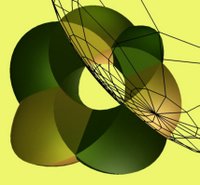

|
The HyperSphere, from an Artistic point of Viewpart of Rebecca Frankel's Web Site |
 First, what does it mean to look at an object that lives in four
dimensional space? Isn't four dimensional space just too big,
dimensionally speaking, for us to imagine? It would be, except that I
am restricting my attention to four dimensional objects that live on
the surface of a sphere. The surface of the hypersphere is three
dimensional -- we could walk around on a hypersphere and not know the
difference from our own space. In fact, it may be true that our own
world is a very large hypersphere. If you got in a space ship and flew
off into space in a straight line, would you go on forever? Or
perhaps, like Pooh Bear lost in the woods, would you uncannily find
yourself coming back to the place from which you started? Even when
you are traveling in a constant heading in three-dimensional space,
the path you follow can seem to strangely twist back on itself. This
is because three dimensional space can be curved, just as two
dimensional space can be curved like the surface of a sphere or a
hyperbola. Just as two-dimensional beings living on the surface of a
large sphere see a flat world around them, but become flustered to
find that their long journeys take them back to where they started, it
is possible that our three-dimensional space is the curved surface of
a huge four-dimensional sphere, and our long journeys would take us
back to our beginning point. We do not have any
spaceships fast enough to directly investigate the curvature of the real
universe, but astronomers can detect curvature by looking at distant
galaxies. They have discovered that there are portions of our space,
at least, that are curved. Viewing the surface of smaller four-dimensional
spheres helps us understand what it means for a space to be curved.
First, what does it mean to look at an object that lives in four
dimensional space? Isn't four dimensional space just too big,
dimensionally speaking, for us to imagine? It would be, except that I
am restricting my attention to four dimensional objects that live on
the surface of a sphere. The surface of the hypersphere is three
dimensional -- we could walk around on a hypersphere and not know the
difference from our own space. In fact, it may be true that our own
world is a very large hypersphere. If you got in a space ship and flew
off into space in a straight line, would you go on forever? Or
perhaps, like Pooh Bear lost in the woods, would you uncannily find
yourself coming back to the place from which you started? Even when
you are traveling in a constant heading in three-dimensional space,
the path you follow can seem to strangely twist back on itself. This
is because three dimensional space can be curved, just as two
dimensional space can be curved like the surface of a sphere or a
hyperbola. Just as two-dimensional beings living on the surface of a
large sphere see a flat world around them, but become flustered to
find that their long journeys take them back to where they started, it
is possible that our three-dimensional space is the curved surface of
a huge four-dimensional sphere, and our long journeys would take us
back to our beginning point. We do not have any
spaceships fast enough to directly investigate the curvature of the real
universe, but astronomers can detect curvature by looking at distant
galaxies. They have discovered that there are portions of our space,
at least, that are curved. Viewing the surface of smaller four-dimensional
spheres helps us understand what it means for a space to be curved.
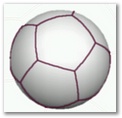
The difficulty with viewing an object on a hypersphere is not being able to see it -- it is, after all, a three dimensional object living in a three dimensional space -- but being able to see all of it. It is an object that lives in a curved space, and we want to see it flattened out. Imagine, by analogy, a flatlander viewing something drawn on the surface of a two-dimensional sphere. He could walk around on the sphere's surface, looking at the object, but he could never see all of the sphere that way, because there would always be part of it beyond the horizon. So any object that was drawn on the whole sphere would only partially be available to view. Alternately, as Edward Abott famously describes in his book Flatland, he could view the sphere as it passes through his flat space. However, it takes quite an act of imagination to reconstruct a full sphere from its successive cross-sections. This isn't impossible: if we are willing to accept some distortion we can project the whole surface of the sphere onto three dimensional space.

Suppose a flatlander wished to view structures on a sphere from his comfortable planar home. He could arrange for a transparent sphere to sit on the plane with a light placed at the top, so that all the circles drawn on the sphere would cast shadows down onto his plane. Now these shadows would be distorted images of the original circles, so the images would still seem unnaturally large in the distance, but angles and approximate shapes would be preserved. The flatlander could sit well away from the point where the sphere rested, and watch the play of shadows as the sphere rotated.
It is easiest to understand this process by looking at the analog in
two dimensions. Above we see a sphere with the edges of dodecahedron
projected onto it (it is as if we took a dodecahedron with stretchy
faces and blew it up unto a sphere, like a soccer ball). Now imagine
the sphere is transparent and we put a light on the top. We can shine
the light down on the plane and see the shadows of the edges of the
dodecahedron on the plane. The name for this method is
stereographic projection.
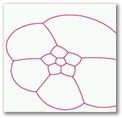
Above right we see the twelve faces of the dodecahedron
projected on the plane this way. Can you pick them out? The projection
of the bottom face is hidden underneath the small sphere; the second
row of five faces projects to the small five-pointed flower image;
the next row of five to the bigger more curved images, and the final
top face is projected out to infinity, forming the "background" for the
figure. Since this might be difficult to see with the sphere in the way, I
have provided another image of the projection, with the original
sphere removed, to the left.
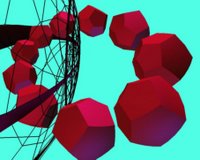
This projection
distorts our shape, the dodecahedron, but in a predictable way. All
the faces of our dodecahedron are identical regular pentagons, but
in the projection they look quite different from each other. In
particular, the images towards the center look abnormally small,
while the images towards the edges seem abnormally large -- and any
face that passes through the projection point gets blown up
infinitely large and becomes the "background." Also, straight
lines are no longer straight: they become sections of circles, and
as they approach the edges of the projection they become more and
more noticeably curved. However, angles are preserved, so it is not
too difficult to see that we are looking at pentagons -- distorted,
for sure, but still most definitely pentagons.
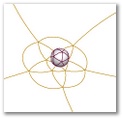
The advantage of this projection is that it would help a flatlander to
get a concept of a three-dimensional dodecahedron without having to
mentally reconstruct slices of the body as it passed through his
space. He could wander among the shadow lines on his plane, and if he
had the imagination to mentally correct for the funny distortion of
lines and areas, he could get a sense of a figure with twelve equal
pentagonal faces wrapped on a sphere. Maybe he wouldn't know
everything there is to know about a dodecahedron, but he could learn
many of the most important things: how it was connected, its
regularity and its symmetry. He can still see the essential three-fold
and five-fold symmetry of the dodecahedron. We can imagine a
flatlander looking at this projection and intuiting from it an idea
of the original object. In particular, this
projection makes it possible to intuit the inherent symmetry of this
object. These properties are much harder to convey using the
two-dimensional slices model.

Our next step is to assign the task we have just watched our hypothetical flatlander perform to ourselves. We want to wander among the shadows of the "faces" of a four dimensional polyhedron and reconstruct in our imagination a concept of its connectedness, regularity and symmetry. But in four dimensions an "face" will actually be a body, a three-dimensional object. Look up above at the green object pictured at the start of this essay. Does it have a form that looks familiar? See the small inner star, and the larger more curved outer leaves? Can you see the underlying regularity, the consistent pentagonal shapes, with, now another layer of consistent dodecahedrality? It looks like our original projection, except that now it is more complex.
 The image above is, as you might have guessed, the
projection of the faces of a four-dimensional analog of a
dodecahedron. We are looking at the "shadows" of the faces of this
figure, which are ordinary three-dimensional dodecahedron. We aren't
seeing all of the faces: if we showed them all we wouldn't see
anything but the inside of the one which projected to infinity. Some
faces have been removed to make the picture easier to view -- in fact,
we are looking at exactly half the faces. To imagine the whole
shape one would have to imagine another exact copy of this figure
fitted into this one -- but don't worry too much about trying to bend
your mind around this concept here, for we will talk more about it
later. The only thing that matters now is to get a sense of the
regularity underneath the distortion.
The image above is, as you might have guessed, the
projection of the faces of a four-dimensional analog of a
dodecahedron. We are looking at the "shadows" of the faces of this
figure, which are ordinary three-dimensional dodecahedron. We aren't
seeing all of the faces: if we showed them all we wouldn't see
anything but the inside of the one which projected to infinity. Some
faces have been removed to make the picture easier to view -- in fact,
we are looking at exactly half the faces. To imagine the whole
shape one would have to imagine another exact copy of this figure
fitted into this one -- but don't worry too much about trying to bend
your mind around this concept here, for we will talk more about it
later. The only thing that matters now is to get a sense of the
regularity underneath the distortion.
Above we see another image of a selection of faces from the 4D dodecahdral polytope which might be easier to interpret. The solid "faces" of this hyper-dodecahedron have been pulled away from each other slightly, which makes it easier to see that they are all reasonably similar dodecahedron. The big mesh sphere is the projection of the "equator" of our sphere. The middle dodecahedron on the section to the right of the "equator" lies at the north pole, while the middle one at the left lies on the south pole. Perhaps this view makes the underlying regularity clearer: it is easier to see that the two halves are basically equal, with only slight distortion because of the projection.
 Let us look at another example, to get a sense of how this
works. Above we see a pair of two-dimensional projections, this time
of an icosahedron. Notice the triangles have changed, in the
projection, into another characteristic petal shape. They distort
slightly as the sphere is rotated under the light that sits at its
top. Notice the characteristic shapes of the distorted triangles. Now,
we can see a similar characteristic shape in the image above, which is
a projection of a four-dimensional polytope called the 24-cell. In
this image, only alternate solid "faces" are pictured, so we can get an
idea of the shape. Note the faces of this shape look like three
dimensional analogues of our original petal-shaped triangles. By
comparing the projections in these different dimensions, we can gain
an intuition which allows us to imagine the form of the original
four-dimensional polytope.
Let us look at another example, to get a sense of how this
works. Above we see a pair of two-dimensional projections, this time
of an icosahedron. Notice the triangles have changed, in the
projection, into another characteristic petal shape. They distort
slightly as the sphere is rotated under the light that sits at its
top. Notice the characteristic shapes of the distorted triangles. Now,
we can see a similar characteristic shape in the image above, which is
a projection of a four-dimensional polytope called the 24-cell. In
this image, only alternate solid "faces" are pictured, so we can get an
idea of the shape. Note the faces of this shape look like three
dimensional analogues of our original petal-shaped triangles. By
comparing the projections in these different dimensions, we can gain
an intuition which allows us to imagine the form of the original
four-dimensional polytope.
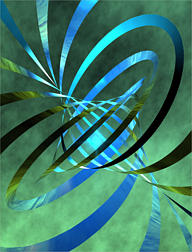
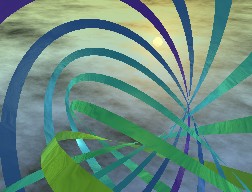 In particular, to give you an idea of the new dimensions in hairstyle
available in four dimensional, note that there is more than one way to
divide all the "hair" into two sections, i.e. to make a part. You can
divide it much the same way one would make a part on a
three-dimensional head. In this case the dividing line of the "part"
would not be a circle drawn on the "head" -- it would be a
sphere. Since we are dimension higher, the "part" is also an object of
one higher dimension. To get an idea of how this looks (in
projection) we show above an image of a four sphere parted -- into six
equal sections, not two. This is how one would make parts if one was
preparing to braid six cornrows on the head of our four-dimensional
woman. Notice how the dividing surfaces are portions of spheres.
In particular, to give you an idea of the new dimensions in hairstyle
available in four dimensional, note that there is more than one way to
divide all the "hair" into two sections, i.e. to make a part. You can
divide it much the same way one would make a part on a
three-dimensional head. In this case the dividing line of the "part"
would not be a circle drawn on the "head" -- it would be a
sphere. Since we are dimension higher, the "part" is also an object of
one higher dimension. To get an idea of how this looks (in
projection) we show above an image of a four sphere parted -- into six
equal sections, not two. This is how one would make parts if one was
preparing to braid six cornrows on the head of our four-dimensional
woman. Notice how the dividing surfaces are portions of spheres.
This is not the only way to divide the sphere, however. We can also
divide the hair into two sections using a torus as our dividing
line. That is to say, we can also find a torus that cuts the four
dimensional sphere into two pieces. Above you can see images of the
dividing torus (projected). The dividing torus has been cut into
ribbons, so we can see it projected in our space. The ribbons on the
torus suggest how to comb the hair on a sphere: we can make the
dividing line of the "part" into a torus -- and it is possible
to comb the hair on a torus. I have included a picture of the flow
along this torus, from two different perspectives. Because it would be
hard to see individual "hairs" in this flow, I have taken two equally
spaced "hairs" -- or "fibres" as they are called in mathematics -- and
connected them with a surface to make a ribbon, as I mentioned
before. So we see ribbons twisting around a projected torus.
Look carefully at these ribbons. Notice that every single one has a
twist in it. If this is hard to see in these small images, click on
the picture to magnify it. The flow that wraps smoothly around
the torus is made up of circles that do not intersect, and each
circle is linked inside every other circle exactly once. So when we
connect two circles as a ribbon, these ribbons have an elegant twist
to them. These linked circles and single twists are ubiquitous in
images of the four dimensional sphere. They add particular harmony to
the images. Below are examples drawn with more distance between the
connected circles, so the ribbons are drawn wider. In these images,
the twist is more visible.
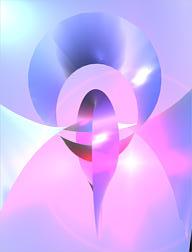

Now that we have looked at the torus that divides the sphere in half,
and the family of circles in which each circle links every circle
exactly once, I want to return again to the subject of four
dimensional polyhedra, which are often called "polychora". The
surprising property of the four dimensional sphere -- that you can
"comb its hair" -- applies also to the polyhedra in four dimensional
space. That is, just as you can find a smooth flow that takes the
whole sphere to itself, you can also find a flow of the discrete faces
of a polychora onto each other that brings it back to itself. That
means it is interesting to look at subsets of the faces which
make up elements of the flow. This is an entirely emergent property
of four dimensions -- by contrast, there aren't any subsets of the
faces of a three dimensional polyhedron that have any particular
physical or mathematical meaning. Four dimensions is different,
however. This essay can not explain the full story of the exceptional
properties of the four dimensional sphere, but it aspires to give you
a taste for them.
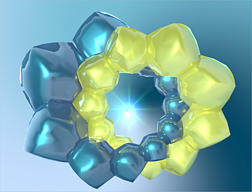
For example, let us return, as promised, to consider the half
hyper-dodecahedron which decorates the top of this article. There are
one hundred and twenty solid faces in this four dimensional version of
the dodecahedron, and I show a solid made up of half of them, sixty in
all. How did I choose this particular half-object? Well, considering
the earlier discussion, you may guess that I found a way to part the
dodecahedron into two solid tori, in much the same way the sphere
itself can be cut in half with a torus. Now the next natural question
is: can we find a smooth flow of linked circles that wraps around this
torus? Yes we can: at left we see two linked circles which have been
selected from sixty faces of our half-dodecahedron. Each circle is
made up of ten solid faces. The whole tori that makes up our
half-dodecahedron contains six of these linked circles. If you look
carefully again at the image of the whole tori, perhaps you can pick
out the circles that wrap around the figure. These characteristic
linked circles show up everywhere in images of the denizens of four
dimensional space, and lend the images their particular harmony.

The hyper-dodecahedron is not the only four dimensional polytope to contain these characteristic linked rings. Below we see an image of the characteristic linked rings from another four dimensional figure. This polygon is harder to name, because it does not have a three-dimensional analogue. Its faces are made of truncated cubes, and it has forty-eight cells in all. Just as was the case for the hyper-dodecahedron, we can pick out a torus made up of half of the faces. We see those twenty-four faces pictured below. In order to see the faces more clearly, we have drawn them slightly smaller, so they pull away from each other. This makes it possible to actually see all twenty-four faces. As you can see, this solid tori are made up of three linked rings of eight cells each. In this case, it is actually possible to see how the entire torus is divided into these linked rings.
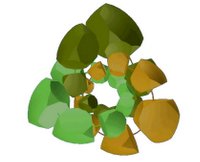 The linked rings show up in another manner as well. Remember the
24-cell that we mentioned earlier? We discussed it when we were
explaining how to understand the projection into three dimensional
space. This is a polygon made up of twenty-four tetrahedral faces. The
image we showed of it earlier was the snaggle-toothed view: we drew
every other point. Now we show an image of one single ring of six
faces chosen from the twenty-four. The equator of the sphere is also
drawn as a mesh in this image, to help us orient ourselves. Now look
carefully at this image. Since the twenty-four cell is a relatively
small polygon, these faces are relatively large, and the whole ring
looks like a solid torus on its own. Notice that the edges of the
tetrahedra describe arcs which continue from one cell to the
next. These arcs make up circles that wrap all the way around our
small torus. So again we see the characteristic circles that wrap
around a torus, this time in yet another context. These are circles
drawn on a single ring of faces, which is itself a circle that
entwines with other circles. Objects embedded in the four dimensional
sphere contain circles within circles within circles. This property
gives them a particular harmony and beauty.
The linked rings show up in another manner as well. Remember the
24-cell that we mentioned earlier? We discussed it when we were
explaining how to understand the projection into three dimensional
space. This is a polygon made up of twenty-four tetrahedral faces. The
image we showed of it earlier was the snaggle-toothed view: we drew
every other point. Now we show an image of one single ring of six
faces chosen from the twenty-four. The equator of the sphere is also
drawn as a mesh in this image, to help us orient ourselves. Now look
carefully at this image. Since the twenty-four cell is a relatively
small polygon, these faces are relatively large, and the whole ring
looks like a solid torus on its own. Notice that the edges of the
tetrahedra describe arcs which continue from one cell to the
next. These arcs make up circles that wrap all the way around our
small torus. So again we see the characteristic circles that wrap
around a torus, this time in yet another context. These are circles
drawn on a single ring of faces, which is itself a circle that
entwines with other circles. Objects embedded in the four dimensional
sphere contain circles within circles within circles. This property
gives them a particular harmony and beauty.
